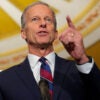Russian Prime Minister Vladimir Putin’s return to power means stability—and stagnation—for Russians and a tough counterpart for both America and Russia’s neighbors.
Putin’s nomination to the Russian presidency means that he may become the longest-serving Russian leader since Joseph Stalin, who ruled for almost 30 years. Putin, who has held power since 2000, may stay at the helm for two more terms of six years each—i.e., until 2024. Moreover, if current President Dmitry Medvedev then assumes power, the “tandem” (as Putin and Medvedev are collectively known) may rule until 2036.
Russia may then face the tradeoff of stability and stagnation. Medvedev, who in 2012 will “rotate” to become Putin’s prime minister, is talking about broad modernization, including the direct election to the Council of the Federation and the upper house of the Parliament and building the “knowledge economy” in Russia. Yet during his presidential term, he has accomplished little.
Putin is talking about selectively importing Western technologies necessary to make Russian defense and energy industries stronger. This is a traditional Russian “catch-up” modernization model, which was in place at least since Peter the Great.
Political modernization will be a challenge under Putin’s presidency. This is regrettable but not surprising. For over three centuries, importation of Western institutions to Russia produced a transformation, which made such political contraptions barely recognizable. Under the czars, after the 1905 revolution, political parties were tiny and impotent.
The parliaments (Dumas) almost never had a true lawmaking function. They have become at best talking clubs. In the Soviet era, the Supreme Soviet became a rubber stamp for most egregious legislation.
The evolution of the post-communist Duma and presidency is a sad testimony to the same process. As before, the all-powerful executive branch—be it the czar, the secretary general, president, or prime minister—more often than not rules by an ukaz, or fiat.
In fact, these Western-sounding and -looking pseudo-institutions such as courts, political parties, and the bicameral parliament made the “managed democracy” into another term for autocracy—more stagnant, stable, and barely capable of deceiving both the Russians and the foreigners. After all, isn’t Russia going to have the Duma and presidential elections? Yet the outcome of these elections is well-known in advance.
As the late Russian Prime Minister Viktor Chernomyrdin famously quipped, “Whichever party we build, the outcome is always the Communist Party of the Soviet Union.” Russian legal and political institutions may have similar frameworks and names as those in the West, but their function and content are often antithetical to their Western counterparts.
Russia has been a conundrum for Western policymakers for centuries. Yet the Obama Administration claimed great progress in its “reset” policies with Russia by establishing friendly relations between President Obama and his Russian counterpart. As The Heritage Foundation continuously warned, these policies will be severely challenged as Putin returns to power.
The Administration claims many accomplishments, including Russia’s assistance in building the Northern Distribution Network to supply NATO troops in Afghanistan, cooperation on the Iran sanctions in the U.N., and arms control. Yet on other key issues, such as NATO and missile defense, the chasm is deep.
Furthermore, the Administration considerably toned down its support for Russia’s neighbors seeking Western orientation and alliances, de facto recognizing the Russian “sphere of privileged interests” there.
With Putin returning (and Medvedev shunted to the Prime Ministry, essentially an economic management slot), Obama and his possible successor, just as other world leaders, will have to deal with Putin. Among the G-8, the Russian leader will become the longest serving, armed with the second largest nuclear arsenal in the world and having Russia’s massive economic resources—including the $400 billion cash cushion, oil and gas reserves, and the raw materials cornucopia—at his beck and call.
For the U.S. and the West, as well as for Russia’s neighbors, the future lengthy Putin rule is going to be a tough challenge—and a rocky ride.































